博文
南京大学研究人员借助无人机创建局域量子网络
 精选
精选
||
南京大学研究人员借助无人机创建局域量子网络
诸平
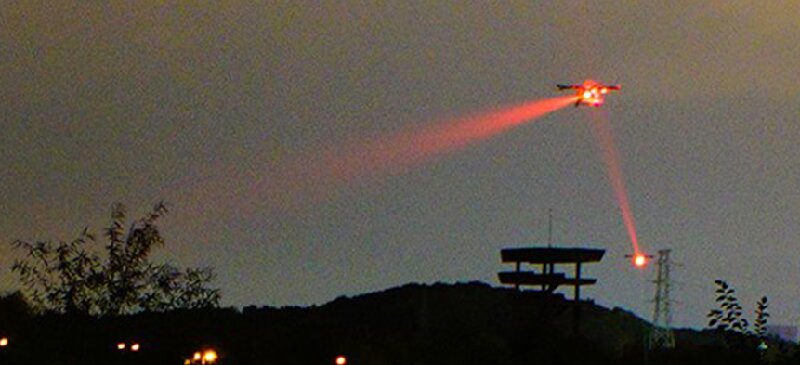
据鲍勃·伊尔卡(Bob Yirka)2021年1月18日(当地时间)通过物理学家组织网(Phys.org)发布的消息,由中国南京大学电子科学与工程学院、物理学院、工程与应用科学学院、先进微结构协同创新中心以及固体微结构国家实验室的研究人员组建的一个研究团队,使用无人机创建了一个小型机载量子网络的原型。相关研究结果已经在《物理评论快报》(Physical Review Letters)发表——Hua-Ying Liu, Xiao-Hui Tian, Changsheng Gu, Pengfei Fan, Xin Ni, Ran Yang, Ji-Ning Zhang, Mingzhe Hu, Jian Guo, Xun Cao, Xiaopeng Hu, Gang Zhao, Yan-Qing Lu, Yan-Xiao Gong, Zhenda Xie, Shi-Ning Zhu. Optical-Relayed Entanglement Distribution Using Drones as Mobile Nodes. Physical Review Letters, 2021, 126, 020503 – Published 15 January 2021. DOI: 10.1103/PhysRevLett.126.020503. 在此论文中,研究人员描述了将纠缠粒子从一架无人机发送到另一架,以及从一架无人机发送到地面的过程。
过去几年里,计算机科学家、物理学家和工程师一直致力于建立一个可用的量子网络。这样做将涉及在用户之间发送纠缠粒子,其结果将是有史以来最安全的网络。作为这一努力的一部分,研究人员已经通过光纤电缆、发射塔之间、甚至从卫星上将纠缠的粒子发送到地面。在这项新的努力中,研究人员又增加了无人机的新元素。
要建立远程量子网络,卫星似乎是理想的解决方案。但对于较小的局域网络,例如同一城市的用户之间的通信,则不必要通过卫星,而需要另一种选择可能更为合适。虽然建塔可以有一些用途,但它们有意或无意的会受到天气和障碍物的影响。为了解决这个问题,研究人员使用无人机来携带信号。
这项工作包括建造一个小型激光产生装置,并将其固定在其中一架无人机上。当它发射激光时,光子被一分为二,形成纠缠对。一对光子中的一个指向另一个无人机,另一个指向一个地面站。接收纠缠光子的无人机只作为重新聚焦后的中继,光子被转发到第三个无人机,然后再发送到第二个地面站。无人机上使用了电动装置,以确保发送器和接收器正确排列,以传输纠缠光子。
在原型机中,光子只发送了1 km,但研究人员表示,将无人机移动到更高的位置,可以传输300 km的距离。研究者认为这项技术也可以应用到地面移动车辆上。他们进一步指出,无人机和地面站也可以连接到包含卫星的网络。他们还指出,他们的工作是第一次在两个移动设备之间发送纠缠粒子。更多信息请注意浏览原文或者相关报道。
Drones could help create a quantum internet | Science News
Quantum Encrypted Communication Between Drones ...
Weird quantum Internet could be delivered by drones ...
Entanglement distribution has been accomplished using a flying drone, and this mobile platform can be generalized for multiple mobile nodes with optical relay among them. Here we develop the first optical relay to reshape the wave front of photons for their low diffraction loss in free-space transmission. Using two drones, where one distributes the entangled photons and the other serves as relay node, we achieve entanglement distribution with Clauser-Horne-Shimony-Holt S parameter of 2.59±0.11 at 1 km distance. Key components for entangled source, tracking, and relay are developed with high performance and are lightweight, constructing a scalable airborne system for multinode connectio and toward mobile quantum networks.
Quantum Drones Take Flight
January 15, 2021• Physics 14, 7
A small prototype of a drone-based quantum network has successfully relayed a quantum signal over a kilometer of free space.
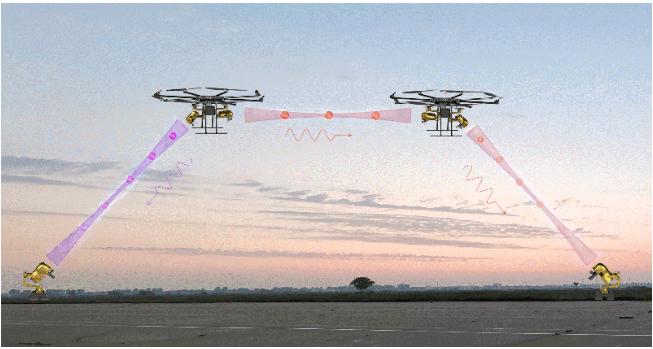
X.-H. Tian, H.-Y. Liu, & Z. Xie/Nanjing Univ.
Droning on. A new quantum communication system consists of a drone (left) that generates entangled photon pairs and distributes them to ground stations. From each pair, one photon (purple beam) goes directly to the ground, while the other (pink beam) is relayed through the second drone (right).Droning on. A new quantum communication system consists of a drone (left) that generates entangled photon pairs and distributes them to ground stations. From each pair, one photon (purple beam) goes directly to the ground, while the other (pink beam)... Show more
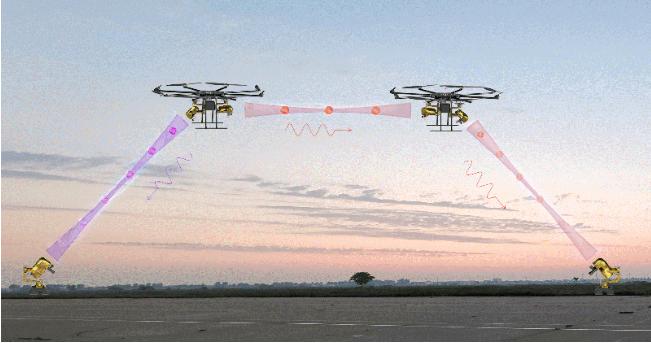
X.-H. Tian, H.-Y. Liu, & Z. Xie/Nanjing Univ.
Droning on. A new quantum communication system consists of a drone (left) that generates entangled photon pairs and distributes them to ground stations. From each pair, one photon (purple beam) goes directly to the ground, while the other (pink beam) is relayed through the second drone (right).×
The airwaves are chock full of “classical” information from cell phones, radio stations, and Wi-Fi hubs, but one day those waves could be carrying quantum encrypted messages or data input for a quantum computer. A new experiment has used a pair of hovering drones to dole out quantum information to two ground stations separated by 1 km [1]. This demonstration could lead to a drone-based quantum network that could be positioned—and easily repositioned—over a city or rural area.
Quantum communication promises fully secure message sharing. For example, two users could exchange encrypted messages using “entangled” photons, pairs of particles with a unique quantum-mechanical relationship. For every pair, one photon would be sent to each of the users, who would be alerted to any eavesdropping by a loss of entanglement between the photons. One of the most common methods for sending such quantum encrypted messages relies on optical fibers (see Viewpoint: Record Distance for Quantum Cryptography). But in fibers, a large fraction of the photons scatter before reaching their destination. More photons can survive if quantum information is transmitted through the atmosphere, as in the quantum link established using a Chinese satellite in 2018 (see Focus: Intercontinental, Quantum-Encrypted Messaging and Video). However, satellites are expensive and difficult to adapt to changing demands on the ground.
Small drones carrying optical equipment could provide a flexible solution that could link multiple users in a quantum network. “Drones can be deployed for a mobile quantum connection at any given time and location when necessary,” says Zhenda Xie from Nanjing University in China. Unlike a fixed tower, drones can also move around to avoid pollution or fog.
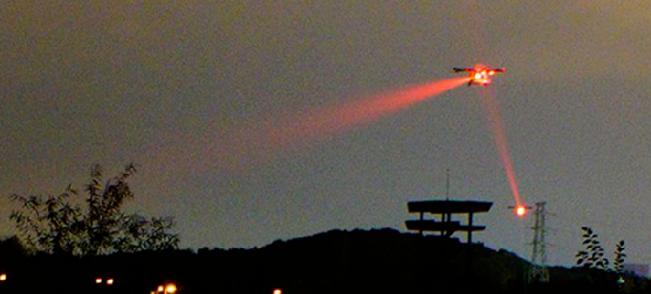
X.-H. Tian, H.-Y. Liu, & Z. Xie/Nanjing Univ.
Target acquisition. The beams from one drone are visible over the testing area.

X.-H. Tian, H.-Y. Liu, & Z. Xie/Nanjing Univ.
Target acquisition. The beams from one drone are visible over the testing area.×
Several teams around the world have been working on drone-based systems. Early last year, Xie and colleagues reported a quantum link using a single octocopter-style drone [2]. The drone generated pairs of infrared photons whose polarization orientations were entangled. Using a high-speed tracking system, the drone directed one photon to a ground station labeled Alice and the other to a ground station labeled Bob. To collect the incoming photons, each station was equipped with a telescope having a 26-mm-wide aperture and a single-photon detector.
However, a major challenge to this form of optical communication comes from diffraction. As each photon propagates, its wave front spreads out, like the beam from a flashlight. If this spreading makes the wave front larger than the telescope aperture, the photon will have little chance of being collected. The team selected a short station-to-station distance of 200 m to ensure that diffraction effects were negligible.
To increase station separation, the team has now added a second drone that acts as a relay between the first drone and Bob. This drone collects photons from the first drone and collimates them through an optical fiber. This process reshapes the photon wave fronts—similar to what a focusing lens does—so that the photons have a higher chance of reaching Bob’s telescope.
In a demonstration, the team positioned the two drones in between Alice and Bob, with drone-to-drone separation of 200 m and drone-to-station separation of 400 m—giving a station-to-station distance of 1 km. The Alice detector recorded about 25% of the photons sent its direction from the first drone, while the Bob detector recorded about 4% of the photons sent towards it.
The team performed a version of the so-called Bell inequality test by comparing the photon polarizations received at Alice and Bob. The results confirmed that the photons remained entangled, so the quantum information survived the trip. The team is now planning to enlarge the size of the network with multiple drones that could provide quantum links across a city, for example.
Georg Harder, a quantum engineer at the Paris-based company Veriqloud, has experience building photon-entanglement systems on large optical tables. “It made me smile when I read that the authors managed to put it all into a drone” he says. He adds that this demonstration opens up new options for quantum communication. “So far, quantum networks require either dedicated fiber networks or very expensive satellite links. The drones complement these existing systems.”
One advantage of a drone system is that it can allow free-space communication between partners that do not have a direct line of sight, says Martin Bohmann, a quantum information specialist at the Austrian Academy of Sciences in Vienna. He points out that photon transmission losses need to be reduced to make a multidrone system competitive with other quantum network technologies, but he believes that such improvements are possible.
–Michael Schirber
Michael Schirber is a Corresponding Editor for Physics based in Lyon, France.
References
H.-Y. Liu et al., “Optical-relayed entanglement distribution using drones as mobile nodes,” Phys. Rev. Lett. 126, 020503 (2021).
2. H.-Y. Liu et al., “Drone-based entanglement distribution towards mobile quantum networks,” Natl. Sci. Rev. 7, 921 (2020).
Weird quantum Internet could be delivered by drones
DAVID PESCOVITZ 8:04 AM FRI JAN 15, 2021
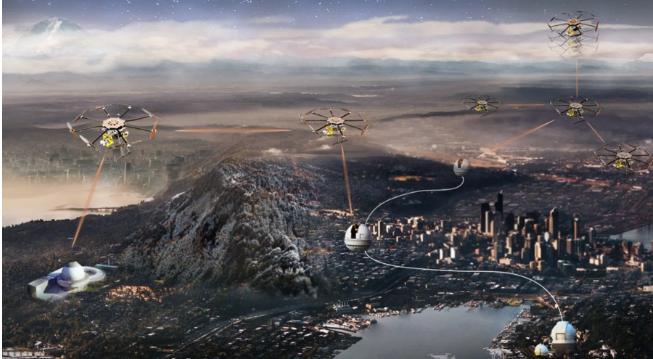
Researchers have used drones to transmit photons that are entangled even when they're far apart. That means their quantum states are linked: Measuring the state of one affects the state of the other. It's weird shit—so weird that Einstein called it "spooky action at a distance." Scientists have explored whether this strange phenomenon could be the basis of a quantum global internet that harnesses the power of entanglement as a communication technology. Now, researchers from China's Nanjing University used drones and base stations to wirelessly relay entangled particles over a kilometer. From Science:
Eventually, scientists aim to build a global quantum internet that relies on transmitting quantum particles to enable ultrasecure communications by using the particles to create secret codes to encrypt messages. A quantum internet could also allow distant quantum computers to work together, or perform experiments that test the limits of quantum physics.
"Optical-Relayed Entanglement Distribution Using Drones as Mobile Nodes" (Physical Review Letters)
IMAGE: XIAO-HUI TIAN, HUA-YING LIU AND ZHENDA XIE
https://blog.sciencenet.cn/blog-212210-1267989.html
上一篇:千万倍放大显示晶体结构的导电性
下一篇:智能手表成为预测COVID-19感染的好帮手